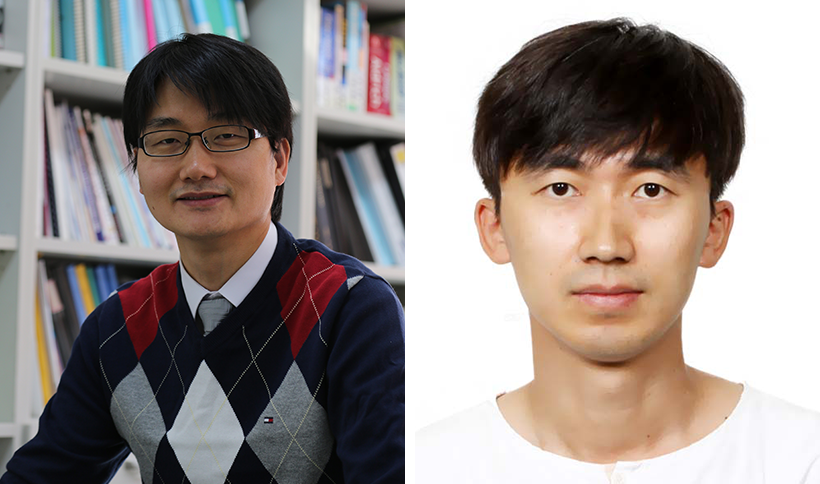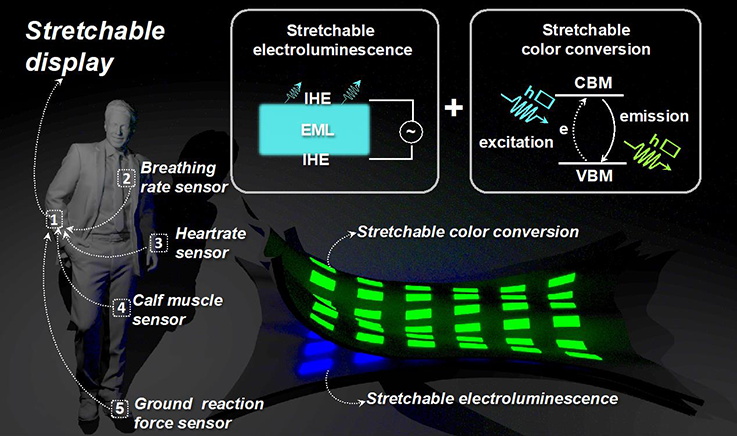Developed using color-conversion layers through the application of perovskite nanocrystals
Identification of the principle of moisture-assisted surface passivation of perovskite nanocrystals

From left, SNU Professor Tae-Woo Lee, and Ph.D. Candidate Student Huanyu Zhou (First Author)
We are expected to take a step closer towards the development of stretchable displays that can be freely bent and folded or even attached to skin - just like those seen in science fiction movies.
A research team led by Professor Tae-Woo Lee of the SNU Department of Materials Science and Engineering, Hybrid Materials, announced on July 29 of the development of stretchable color-conversion layers with perovskite nanocrystals that was successfully applied it to stretchable displays. This research will speed up the development of next-generation stretchable light-emitting devices.
The recent development of flexible material and solution process technology has made it possible to develop wearable devices. For this technique, it is most important to continuously monitor the physiological data of the human body through sensors attached to the skin. One of the fundamental units of wearable devices is a stretchable display that can visualize signals from sensors. In the early days of wearable device development, there was the problem of low portability due to all devices being connected by cable and had devices that were large in volume, but stretchable displays are flexible, and so can be attached to the skin and can conveniently check the signal output from the sensor in real-time.
Polymer and quantum dot can be used to manufacture a stretchable electroluminescent device, but such materials have problems of being susceptible to degradation when exposed to water and oxygen. Degradation refers to organic or inorganic semiconductor materials being exposed to the air and reacting with moisture and oxygen, which will prevent them from maintaining their original properties. In the case of light-emitting devices, the light emitted from the devices is weakened, and in the case of complete degradation, black spots are created.
Currently, stretchable electroluminescent devices need an excellent stretchable encapsulation layer to avoid degradation in the air during longitudinal elongation, and a new breakthrough is needed through the development of encapsulation layer material.
To solve this problem, Professor Tae-Woo Lee's research team developed an air-stable and stretchable perovskite nanocrystals color-conversion layer and combined it with an electroluminescent device to implement a stretchable display.
Perovskite has been superior to existing organic and inorganic light-emitting devices in many respects, including price, quantum efficiency, and color purity, and has many studies that have been conducted regarding this in recent years. However, since perovskite nanocrystals quickly get degraded by moisture and oxygen, Professor Lee's research team used the styrene-ethylene-butylene-styrene polymer matrix to enclose nanocrystals, improving not only the chemical stability of the nanocrystals but also their mechanical elasticity so that they can be applied as a stretchable color-conversion layer.
Passivation eliminates surface defects of perovskite nanocrystals and increases their photoluminescence efficiency. The study is of high value due to the discovery as well as revealing the principle of surface defect passivation of perovskite nanocrystal being possible by controlling the amount of moisture as well as the development of a stretchable display with a combination of stretchable color conversion layer.
The research team also announced that it has implemented white color by combining light emitting elements with stretchable color-conversion layers through the application of perovskite nanocrystals and that the stretchable display can be extended up to 180%, or 1.8 times.
Professor Tae-Woo Lee, the paper's corresponding author, explained the significance of the study, saying, "Stretchable color conversion layers through the use of perovskite nanocrystals will provide a significant stimulus for research regarding the theoretical aspects of perovskites and will take a step forward to affect its practical application in the field of academic and industrial sectors." He further added that "This method will provide a new direction for the development of stretchable displays."

3D schematic of the conceptual application of stretchable display to visualize the signals of wearable sensors. A 3D schematic of a stretchable display using a stretchable color-conversion layer integrated with a stretchable luminous element.
The research findings were published online in the world-renowned international journal <Advanced Materials> on July 26.
For further information, please contact Prof. Tae-Woo Lee.


